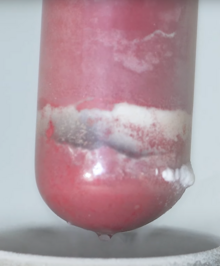Tungsten hexachloride
 α-Tungsten hexachloride
| |||
 β-Tungsten hexachloride
| |||
| |||
| Names | |||
|---|---|---|---|
| IUPAC names
Tungsten hexachloride
Tungsten(VI) chloride | |||
| Identifiers | |||
3D model (
JSmol ) |
|||
ECHA InfoCard
|
100.032.980 | ||
| EC Number |
| ||
PubChem CID
|
|||
RTECS number
|
| ||
| UNII | |||
CompTox Dashboard (EPA)
|
|||
| |||
| |||
| Properties | |||
| WCl6 | |||
| Molar mass | 396.54 g·mol−1 | ||
| Appearance | dark blue crystals, moisture sensitive | ||
| Density | 3.52 g/cm3 | ||
| Melting point | 275 °C (527 °F; 548 K) | ||
| Boiling point | 346.7 °C (656.1 °F; 619.8 K) | ||
Hydrolyzes
| |||
| Solubility in chlorocarbons | soluble | ||
| −71.0·10−6 cm3/mol | |||
| Structure | |||
| α:rhombohedral, β: hexagonal | |||
| Octahedral | |||
| 0 D | |||
| Hazards | |||
| Occupational safety and health (OHS/OSH): | |||
Main hazards
|
oxidizer; hydrolysis releases HCl | ||
| Related compounds | |||
Other anions
|
|||
Related compounds
|
|||
Except where otherwise noted, data are given for materials in their standard state (at 25 °C [77 °F], 100 kPa).
| |||
Tungsten hexachloride is an
standard conditions. It is an important starting reagent in the preparation of tungsten compounds.[1] Other examples of charge-neutral hexachlorides are rhenium(VI) chloride and molybdenum(VI) chloride. The highly volatile tungsten hexafluoride
is also known.
As a
diamagnetic
.
Preparation and structure
Tungsten hexachloride can be prepared by chlorinating tungsten metal in a sealed tube at 600 °C:[2]
- W + 3 Cl2 → WCl6
Tungsten hexachloride exists in both blue and red
polymorphs, referred to respectively as α and β. The wine-red β can be obtained by rapid cooling whereas the blue α form is more stable at room temperature. Although these polymorphs are distinctly colored, their molecular structures are very similar. Both polymorphs feature WCl6 molecules that have octahedral, in which all six W–Cl bonds are equivalent, and their length is equal to 224–226 pm. The densities are very similar: 3.68 g/cm3 for α and 3.62 g/cm3 for β. The low temperature form is slightly more dense, as expected.[3]
Reactions
Tungsten hexachloride is readily
phosphorus oxychloride.[2]
hexamethyl tungsten
:
- WCl6 + 3 Al2(CH3)6 → W(CH3)6 + 3 Al2(CH3)4Cl2
Treatment with
The
aryl
).
Reduction of WCl6 can be effected with a mixture of tetrachloroethylene and tetraphenylarsonium chloride:[5]
- 2 WCl6 + Cl2C=CCl2 + 2 (C6H5)4AsCl → 2 (C6H5)4As[WCl6] + Cl3C−CCl3
The W(V) hexachloride is a derivative of tungsten(V) chloride.
It reacts with
Safety considerations
WCl6 is an aggressively
oxidant, and hydrolyzes to release hydrogen chloride
.
References
- ISBN 978-0-471-93623-7..
- ^ ISBN 978-0-470-13162-6.
- ..
- ^ M. A. Umbreit, K. B. Sharpless (1990). "Deoxygenation of Epoxides with Lower Valent Tungsten Halides: trans-Cyclododecene". Organic Syntheses; Collected Volumes, vol. 7, p. 121.
- .
- ISBN 978-1-4615-4907-9.
- ISBN 978-3-662-13401-6.


